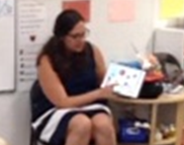Children’s author (and PLOS SciComm contributor) Patricia Newman is celebrating a landmark anniversary of her renowned book on improving our environment. In…
Stephanie Ryan: My Journey from Science Fan to Children’s Book Author
I am  a scientist, and I want to start with how my love of science originated because that is how I got to where I am today. During my elementary school years, my dad would drive our family to Purdue University’s Super Saturday program. We’d wake up extra early, pack bologna sandwiches and sodas into a cooler, and make the two-hour drive to West Lafayette. This program exposed me to all types of hands-on science. We watched bananas freeze instantly in liquid nitrogen and then shatter into tiny pieces when removed. Those early experiences instilled in me a natural curiosity about the world around me. Science was an adventure rather than an intimidating subject matter.
a scientist, and I want to start with how my love of science originated because that is how I got to where I am today. During my elementary school years, my dad would drive our family to Purdue University’s Super Saturday program. We’d wake up extra early, pack bologna sandwiches and sodas into a cooler, and make the two-hour drive to West Lafayette. This program exposed me to all types of hands-on science. We watched bananas freeze instantly in liquid nitrogen and then shatter into tiny pieces when removed. Those early experiences instilled in me a natural curiosity about the world around me. Science was an adventure rather than an intimidating subject matter.
I’ve since made it my career to understand how students learn science. I’m especially interested in how I can help them do that in a non-traumatic way that doesn’t leave them saying, “I hated chemistry!” when they are adults. Most of my work now centers around developing authentic curricular materials and assessments for K-12 and college students.
My career plan did not initially involve becoming a children’s book author; it happened quite by accident. My son, Charlie, about 18 months old at the time, was sorting his toys by color and by shape, and it struck me: so many of the concepts found in general chemistry are about sorting. Just like Charlie was sorting! Of course, in chemistry, we’re sorting matter by atoms, a bit more complex, but still the same basic concept. It seemed to me like a natural way to introduce the beginner concepts of chemistry (and all sciences) to very young learners. And my first children’s book, Let’s Learn about Chemistry, was born. I took the initial draft to my son’s class and edited it further based on questions that he and his classmates had. It was toddler-tested and written in true participatory design fashion!
About the Book: Let’s Learn about Chemistry
The book addresses chemical and physical changes using everyday scenarios. The main characters of the book get to explore solids, liquids, and gases using familiar things like water, soccer balls, and dolls. The book also introduces the different levels we use to describe matter: macroscopic, submicroscopic, microscopic, and symbolic. These experiences will prime early learners for the concept of molecules and matter we aren’t able to see.
This young age is the perfect window to take advantage of a child’s natural curiosity and begin to get children comfortable with scientific language, the scientific method, and the thought processes of scientists. Our children can grow into life-long critical thinkers and questioners of the world around them. I see books like Let’s Learn about Chemistry as serving an essential part of childhood education.
Addressing the Standards without Being “School”
The Next Generation Science Standards* (NGSS) feature science and engineering practices and crosscutting concepts. In that way, I wanted to make sure this book had students interact, to find patterns, and build explanations with evidence, among other skills. The NGSS now focuses on the molecular level in elementary education and places even greater emphasis on sorting and classification skills. So the concepts Let’s Learn about Chemistry introduces will be the science content that they will be covering in just a few years in their classes.
It was also essential to make this book approachable to the adults who would be reading it. I did not want the book to only appeal to fellow chemists and chemistry educators. I worked with a developmental editor and my non-scientist, but science-loving, husband to make sure that the book was engaging for the adults and the children too—even those parents who think they hate chemistry.
Accelerated Learning Principles
Let’s Learn about Chemistry also fits naturally into the guiding principles of accelerated learning. Giving children opportunities to interact with the pages by posing questions creates a dialogue with caregivers and a level of interactivity that is essential to accelerated learning. When I read my book to groups of small children, I ask them about their senses. The book also lets the child create their own patterns of what they think is different, and the adult reading with them is encouraged to validate their answers as well as show them the way that the author categorized it.
I designed this book to be a social learning experience, meant to be read as a group or with an adult, not alone. Another hallmark of accelerated learning is that collaborative experiences aid learning. I designed the book to elicit positive emotions to help foster learning. It uses things that kids play with or experience daily. During live readings, I often hear “I have a soccer ball at home” or comments of that nature (including many fun preschooler facts), linking these science concepts to a child’s real life.
Representation Matters
I wanted to ensure that the book represented all children, so that young readers could see themselves in it. Let’s Learn about Chemistry features my son’s childhood friends, and it just so happens that his friends were of different ethnic backgrounds. The illustrations use their likenesses and real interests. Representation is such an influential force at this stage of development, and I’m happy that so many children can see themselves in my book.
STEM books and toys are often part of a novelty gift or niche market. Because of this, many children are missing out on these types of tools, especially those from less privileged backgrounds. It is for this reason that I donated a copy of the book to every Head Start program in the state of Indiana and have offered the book to daycares and preschools at lower costs. I want all children to have access to these tools! Science should not be elite; it should be open to everyone. And I believe everyone can have a lifelong love of science as long as it is presented as a tool to answer questions about the world and not as something reserved for textbooks and quizzes.
* NGSS a registered trademark of Achieve. Neither Achieve nor the lead states and partners that developed the Next Generation Science Standards were involved in the production of this product, and do not endorse it.
Edited by Bill Sullivan, PhD, Indiana University School of Medicine.


